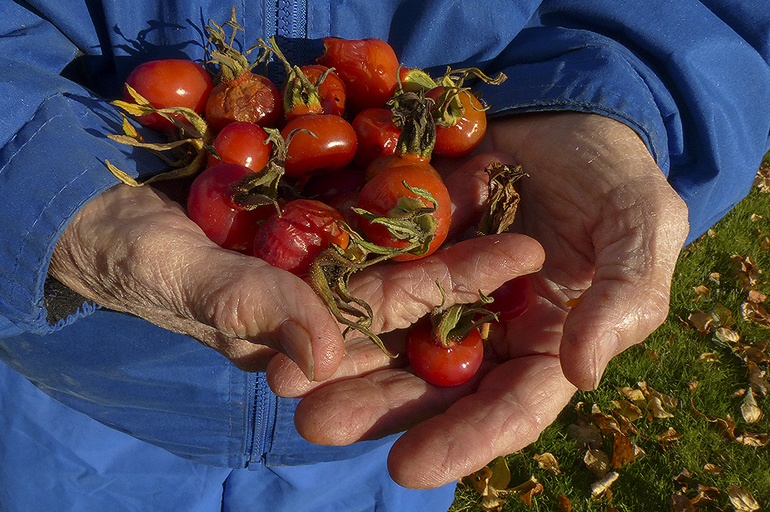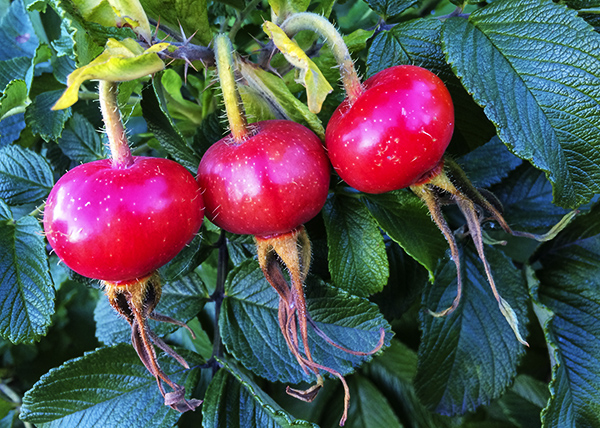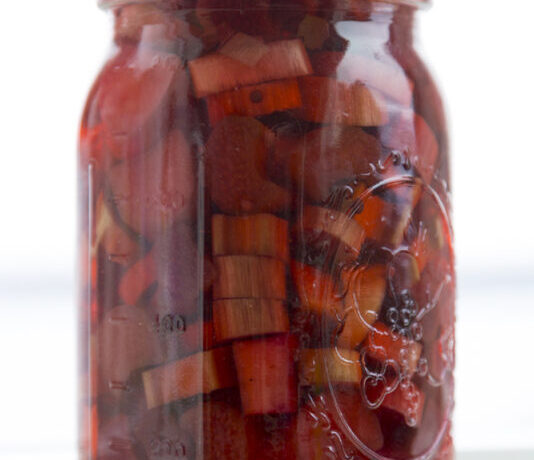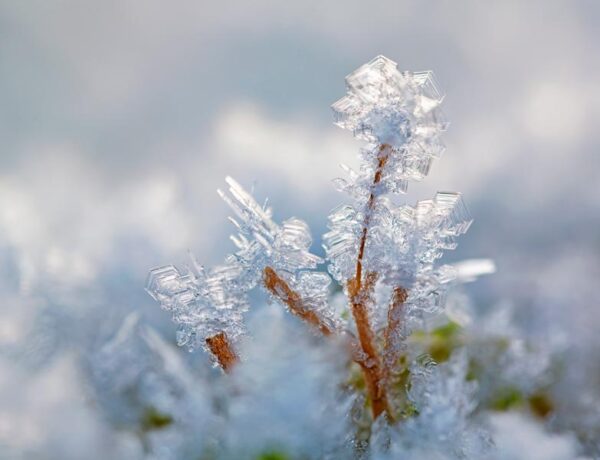It’s funny how marketing wizards embedded in my brain that only oranges were synonymous with vitamin C. But over the years I’ve learned that papaya, strawberries, bell peppers, kale, cauliflower–even broccoli–have more vitamin C than oranges. It gets better. Recently I discovered another super source of vitamin C right outside my door: Rose hips.
I discovered rose hips sort of by accident. I mean, during my summers in Kodiak I pick rugosa rose petals by the quart to impart a sweet-nutty fragrance to cakes and muffins for our wildlife cruises. But I never really dabbled with hips, the fruit of the rose, until I took a different route home one day.
I drove passed a front yard that was edged with large rose bushes festooned with red balls, like Christmas tree ornaments. I asked permission to pick. And pick I did…
Since then I’ve picked at my local credit union (after making a deposit, of course), at my neighbor’s house, and in the lot across from the boatyard. You don’t need any extra equipment to pick rose hips. Just pinch or twist gently to de-stem it. It should feel a little soft, with some give, not hard like a marble. (I’ll cover how to process rose hips in a minute).
Rose hips, also known as haw or rose hep, are one of the richest plant sources of vitamin C available. And I was pleasantly surprised to read that two medium-sized rose hips have more vitamin C than a medium orange. (Eat your hats, marketing wizards!) Plus, they contain vitamins A, B, E and the minerals calcium, iron, and phosphorus.
There’s a saying that roses in general are good for “the skin and the soul.” Turns out rose petals and rose hips have a long tradition of medicinal use.
According to Wikipedia, during World War II, the people of Britain were encouraged through letters to The Times newspaper, articles in the British Medical Journal, and pamphlets produced by Claire Loewenfeld, a dietitian working for Great Ormond Street Hospital for Sick Children, to gather wild-grown rose hips to make a vitamin C syrup for children. This advice arose because German submarines were sinking commercial ships, making it difficult to import citrus fruits. In China, the hips are known as jin ying zi and are mainly used as a kidney chi (energy) tonic, an astringent prescribed for urinary problems.
Like a cross between an apricot and a kumquat
Rose hips have a rich, tangy-sweet flavor, like a cross between an apricot and a kumquat. If you haven’t tried one, find a local bush and sample one. (Wild is best. Either way, be sure it’s pesticide/chemical-free). After taking a shallow bite, (lest you end up with a mouthful of seeds), take a moment to admire the ruby-red outside and the salmon-orange inside.
So what do you do with these beautiful orbs? Rose hips are happy campers. They can be used fresh, dried or preserved in a variety of dishes, including syrups, preserves (rose hip catsup is superb) jams (my favorite is rose hip-orange marmalade) and jellies, teas (often mixed with hibiscus), sauces, breads and desserts.
And fall is the best time for gathering rose hips. They should be bright orange or red, and preferably kissed once or twice by Jack Frost. Remember, go for the soft hips, not hard ones.
Two basic ways to prepare rose hips for recipes:
- Dried
- Cooked and pureed

Discovering Wild Plants is one of my favorite wild plant books. Full of lore, recipes, medicinal applications and more. Though out of print, you can find used copies online. Janice told me she plans to re-publish it. Good news.
Either way, you’ll first need to rinse them off and then pinch off the dried, octopus-looking flower end.
To dry rose hips
Spread them on a cookie sheet. Place them in an oven set on the lowest setting. A dehydrator works great, too, or simply put them in a dark, well-ventilated area to dry. After drying (thoroughly, to prevent mold), store them in glass jars in a dark, cool place.
To make rose hip tea, trim off the flower stem, cut the hip in half (and again in quarters, if they’re large), and scrape out the seeds and hairy pith. (A vegetable peeler or knife tip are good tools for the job). This can be very tedious with small hips, so save the small ones for jellies. [Note: Rose hips used for jellies don’t need to be seeded or scraped. Janice Schofield, author of the out-of-print book, Discovering Wild Plants, says “most people prefer to de-seed their rose hips, but it’s not absolutely necessary.”] By the way, a half and half mixture of rose hip juice and apple juice makes a tasty jelly.
You can use dried rose hips in place of raisins in quick bread recipes or sprinkle them on oatmeal or granola. They also freeze well. Here’s a recipe for Rose Hip Nut Bread, I adapted from the book, Cooking Alaskan:

This book has the best recipes for all kinds of seafood, wild edibles and more. A classic for all cooks.
Rose Hip Nut Bread
- 1 cup orange juice
- 1/2 cup raisins
- 3/4 cup seeded and chopped rose hips
- 2 TBL melted butter
- 1 teaspoon vanilla
- 1 egg, slightly beaten
- 1-1/2 cups flour
- 1 cup sugar
- 1 teaspoon baking powder
- 1/2 teaspoon baking soda
- 1/4 teaspoon salt
- 1/2 cup chopped nuts, sesame or sunflower seeds
In a large bowl, mix the first six ingredients. Sift together dry ingredients and blend with wet mixture, stirring only until moistened. Fold in nuts or seeds and spoon into a greased, 5×8-inch bread pan, muffin tins or 9×9-inch cake pan. Bake at 350 degrees F for one hour (less for muffins and a 9×9 pan).
To make rose hip puree
Gather your rose hips, clean them and either chop them or put them in a pan with a little water and cook them on low heat until soft. I use a potato masher to speed up the process. Don’t be afraid to add extra water to keep them from sticking. The hips tend to absorb water.

Okay, so this looks awful, but it’s an ugly duckling kind of photo. It gets better with the next stepl
 After you’ve created a mash, run it through a food mill, a very handy gadget for pureeing apples, creaming soups, ricing potatoes and so on.
After you’ve created a mash, run it through a food mill, a very handy gadget for pureeing apples, creaming soups, ricing potatoes and so on.
The photo below shows the end product: Isn’t it beautiful?

After running the seedy rose hip pulp through a food mill, what remains is a beautiful, silky puree.
From here, you can create all sorts of things:
Jazz up your next pumpkin, apple or rhubarb pie by replacing some of the ingredients with rose hip pulp or chopped bits.
Here is a simple recipe for Rose Hip Soup, heartwarmingly wonderful on a snowy day. (It’s a variation of Nyponsoppa, the popular delicacy served in Sweden).
Rose Hip Soup
- 4 cups rose hip pulp + additional water
- 2 TBL sugar (or to taste)
- Cardamom and/or cinnamon (optional)
- Lemon juice
- Orange or lemon zest
- 2 TBL cornstarch
Bring pulp and water to a boil and add sugar, seasoning, lemon juice and zest. Thin with more water to a desired consistency. Mix cornstarch with a few teaspoons of cold water. Add it to the soup while stirring. To serve, top with vanilla yogurt or ice cream and shaved almonds or toasted coconut.
Variation: Mix half and half with rhubarb sauce or applesauce
There you go. Roses aren’t just beautiful to look at and sniff during the summer. They’re incredibly edible, all year. If you have a favorite recipe using rose hips, I’d love to hear from you. Meanwhile, thanks for visiting.
~ ~ ~ ~ ~ ~

I spend much of my summers on our boat, cooking for dinner cruise guests and running wildlife viewing trips in Kodiak, Alaska.
Marion Owen is co-author of the New York Times bestseller, Chicken Soup for the Gardener’s Soul. She is a professional photographer writes a weekly garden-food column for the Kodiak Daily Mirror, in Kodiak, Alaska, and teaches photography and gardening through the University of Alaska. Find her on Facebook, and Google+.







No Comments